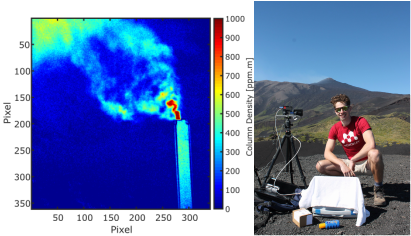 Left - Example image of sulphur dioxide emissions from a power station. The image was created using two different wavelengths of UV light. Right - Tom Wilkes on the flanks of Mt Etna with the Raspberry Pi UV camera system. Left - Example image of sulphur dioxide emissions from a power station. The image was created using two different wavelengths of UV light. Right - Tom Wilkes on the flanks of Mt Etna with the Raspberry Pi UV camera system. Last week our article "Ultraviolet Imaging with Low Cost Smartphone Sensors: Development and Application of a Raspberry Pi-Based UV Camera" was published in the Journal Sensors. The article is fully open access so can be downloaded in full! This work is the result of a continuing collaboration between the Department of Geography and the Department of Electronic and Electrical Engineering at the University of Sheffield, with the majority of the leg work done by current PhD student Tom Wilkes (Geography). In my last blog post, I talked about ultraviolet (UV) cameras, how they work, the improvements on previous techniques, and why we need them. However, the majority of current UV cameras are quite expensive! For a completely functioning system the costs may range anywhere between £10k to £50k. In our latest paper we detail a new method which uses the low cost Raspberry Pi camera and the Raspberry Pi computer to significantly reduced the costs of a complete UV camera system to perhaps <£500. There are also several other benefits of using the Raspberry Pi based set-up, including: a reduction in power needs, a reduction in the weight, and the ease of finding necessary parts. The majority of digital cameras and sensors such as the Raspberry Pi camera, when they are used unaltered, are sensitive only to visible light. This makes sense, as most of the time we want to take pictures which resemble what we see with our eyes! However, by removing certain layers from the surface of the camera sensor we can significantly increase the sensitivity to UV light at the wavelengths needed to measure the absorption of UV light by sulphur dioxide for example (see Figure above and video below for example application at a power station). There are also several other UV imaging applications which could benefit. The development of this new method also necessitated the purchase of new lenses (to focus the UV light onto the sensor) and the design of a new lens holder which was 3D printed. For full details see the published paper. Being a part of the development of this new method from the outset has been fantastic fun, and it is always amazing when everything turns out better than expected! Comments are closed.
|
Archives
July 2023
|

 RSS Feed
RSS Feed